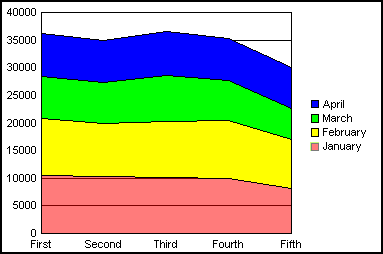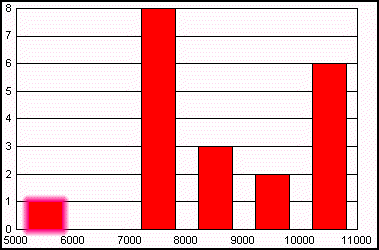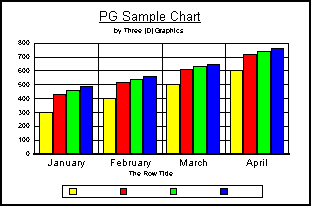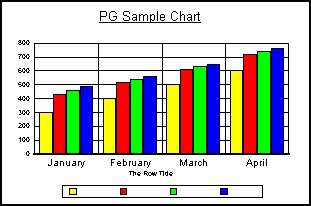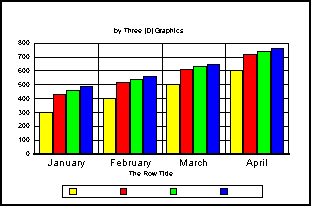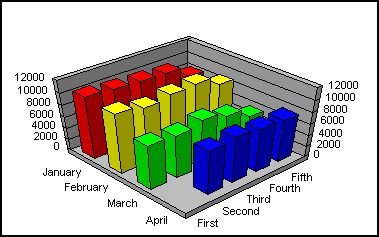| |
This attribute sets the background color for patterns. |
|
Type: |
typedef struct {
UINT16 red; //0...65535
UINT16 green; //0...65535
UINT16 blue; //0...65535
} RGB16, FAR *RGB16Ptr; |
|
Valid Range: |
See the RGB16 structure in Appendix A. |
|
Default: |
255,255,255 (White) |
|
Example: |
static RGB16 aRGB[8] = {0,0,0}/* BLACK */
SetGraphAttrSI(gpGraph,gpSelItem,
A_AREABACKCOLOR,&aRGB[1]); |
|
Notes: |
If you use SetGraphAttr(), you must specify the object ID of an area object to indicate the object to which this attribute is to be applied. See Appendix B for a list of area objects. You may use a series ID to select a particular area object. |
|
Also See: |
A_AREACOLOR_NONE, A_AREACOLOR_RGB, A_AREACOLOR_ALPHA |
|
Usage |
ObjectID |
SeriesID |
GroupID |
GraphTypes |
|
Requirements: |
Area |
Optional |
Optional |
All |
| |
|
| |
This attribute can be used to make an area object transparent. If the area is transparent, the underlying elements are seen behind the area. If you use setGraphAttr() to apply this attribute, specify the object ID of a particular area object. Use a group and/or series ID to select a particular instance of an area object. |
|
Type: |
BOOLEAN16 |
|
Valid Range: |
TRUE/FALSE |
| |
TRUE= |
This area has no color; it is transparent. |
| |
FALSE= |
This area is not transparent; use the normal color settings. |
|
Default: |
FALSE |
|
Example: |
SetGraphAttrSI(gpGraph,gpSelItem,A_AREACOLOR_NONE,&bTRUE); |
|
Notes: |
This attribute overrides A_AREACOLOR_RGB when drawing occurs. If A_AREACOLOR_NONE is TRUE, the area will remain transparent regardless of the A_AREACOLOR_RGB setting. This attribute must be explicitly set to FALSE in order to see an area's color. |
|
Also See: |
A_AREABACKCOLOR, A_AREACOLOR_RGB, A_AREACOLOR_ALPHA |
|
Usage |
ObjectID |
SeriesID |
GroupID |
GraphTypes |
|
Requirements : |
Area |
Optional |
Optional |
All |
| |
|
| |
This attribute sets the color of an area object. If you use setGraphAttr() to apply this attribute, specify the object ID of a particular area object. Use a group and/or series ID to select a particular instance of an area object. |
|
Type: |
typedef struct {
UINT16 red; //0...65535
UINT16 green; //0...65535
UINT16 blue; //0...65535
} RGB16, FAR *RGB16Ptr; |
|
Valid Range: |
See the RGB16 structure in Appendix A. |
|
Default: |
None |
|
Notes: |
1. |
For API use via Set/GetGraphAttr(), a copy of the structure RGB16 should be used (e.g., RGB16 myRGBstruct;). |
| |
2. |
The library does not modify the system color palette. If your application requires colors in addition to those in the system palette, your application must create and realize a logical palette into the system palette. |
| |
3. |
If an ObjectID and/or Series ID is not specified or SetGraphAttrSL is used to apply the attribute, the color will be applied to all area objects. |
| |
4. |
If the O2D_RISER ObjectID is used and A2D_COLORBYSERIES is FALSE (color by group), the SeriesID will actually select the group rather than the series. |
| |
5. |
For more accurate color with ACM_COLOR_MODEL, set this attribute after DrawTheGraph() or DryRunTheGraph(). |
| |
6. |
You can set the PGSDK default area instance by setting Object ID, Series ID, and Group ID to -3. This default area will be the initial color assigned to any annotation object created by CreateAnode(). |
|
Also See: |
A_AREABACKCOLOR, A_AREACOLOR_NONE, A_AREACOLOR_ALPHA, A2D_COLORBYSERIES, ACM_COLOR_MODEL |
|
Usage |
ObjectID |
SeriesID |
GroupID |
GraphTypes |
| |
Area |
Optional |
Optional |
All |
| |
|
|
|
|
| |
This attribute assigns a drop shadow to an area object. The drop shadow is drawn with the color specified, offset from the object by the virtual coordinate of nXoff and nYoff. If you use setGraphAttr() to apply this attribute, specify the object ID of a particular area object. Use a group and/or series ID to select a particular instance of an area object. |
|
Type: |
typedef struct {
INT16 nXoff; /* virtual x offset */
INT16 nYoff; /* virtual y offset */
UINT16 nRed; /* RGB values */
UINT16 nGreen; /* RGB values */
UINT16 nBlue; /* RGB values */
} DropShadowInstRec, FAR *DropShadowInstPtr; |
|
Valid Range: |
See the DropShadowInstRec in Appendix A. |
| |
nRed, nGreen, and nBlue: 0...65535 for desired color |
|
Default: |
None |
|
Example: |
DropShadowInstRec Shadow;
Shadow.nXoff = 100;
Shadow.nYoff = 120;
Shadow.nRed = 0;
Shadow.nGreen = 0;
Shadow.nBlue = 0;
UpdateMenu (hmenu,&wEffect,wParam);
SetGraphAttrSL(gpGraph,gpList,A_AREADROPSHADOW,&Shadow); |
|
Notes: |
1. |
If you use SetGraphAttr(), you must specify the object ID of an area object to indicate the object to which this attribute is to be applied. See Appendix B for a list of area objects. You may use a series ID to select a particular area object. |
| |
2. |
Setting nXoff and nYoff to zero disables any previous drop shadow. Drop shadows are not objects and cannot be selected, they are considered attributes of an object. |
|
Usage |
ObjectID |
SeriesID |
GroupID |
GraphTypes |
| |
Area |
Optional |
Optional |
All |
| |
This attribute assigns a pattern to an area object. For Windows applications, the system uses the patterns installed by default. If you use setGraphAttr() to apply this attribute, specify the object ID of a particular area object. Use a group and/or series ID to select a particular instance of an area object. |
|
Type: |
INT16 |
|
Valid Range: |
-6...6 |
| |
-6 = |
Diagonal cross with transparent background |
| |
-5 = |
Cross with transparent background |
| |
-4 = |
Backward diagonal with transparent background |
| |
-3 = |
Forward diagonal with transparent background |
| |
-2 = |
Vertical with transparent background |
| |
-1 = |
Horizontal with transparent background |
| |
0 = |
Solid |
| |
1 = |
Horizontal with solid background |
| |
2 = |
Vertical with solid background |
| |
3 = |
Forward diagonal with solid background |
| |
4 = |
Backward diagonal with solid background |
| |
5 = |
Cross with solid background |
| |
6 = |
Diagonal cross with solid background |
|
Default: |
0 (SOLID) |
|
Example: |
See SAMP14.C
SetGraphAttrSI(gpGraph,gpSelItem,A_AREAPATTERN,&pat[1]); |
|
Notes: |
1. |
In the current Windows architecture, patterns can only have one of the 20 colors defined in the Windows default palette. If any other color is assigned to the pattern, Windows will use the closest "pure color" match it can find. Use the A_AREACOLOR_RGB attribute to set/change the color of the pattern. The background color is always white and cannot be changed. |
| |
2. |
These patterns are the current test patterns in our SHELL application. The actual number and description of patterns may change based on the controlling application. |
|
Also See: |
A_FONT_PATTERN, A_LINE_PATTERN |
|
Usage |
ObjectID |
SeriesID |
GroupID |
GraphTypes |
|
Requirements: |
Area |
Optional |
Optional |
All |
| |
|
|
|
|
| |
This attribute applies a special effect (e.g., wash or bitmap/picture) to an area object. If you use setGraphAttr() to apply this attribute, specify the object ID of a particular area object. Use a group and/or series ID to select a particular instance of an area object. |
|
Type: |
typedef struct
{
INT16 effect;
union
{
WashRecord wash;
PictureRecord picture;
BrushRecord brush;
AdvancedWashRecord advwash;
} info;
} FXStruct, *FXPtr; |
|
Valid Range: |
See the FXStruct data structure in Appendix A. |
|
Default: |
None. |
|
Example: |
FXStruct aSFX;
aSFX.effect = ADVANCED_WASH_FX;
aSFX.info.advwash.startColor = aRGB[4];
aSFX.info.advwash.endColor = aRGB[0];
aSFX.info.advwash.nOffsetX = 50;
aSFX.info.advwash.nOffsetY = 100;
aSFX.info.advwash.nAngle = 45;
aSFX.info.advwash.nSteps = 0;
aSFX.info.advwash.nWashType = WashLinear;
aSFX.info.advwash.nScale = 0;
SetGraphAttrSL( gpGraph, gpList,A_AREASFX, &aSFX ); |
| |

|
|
Notes: |
1. |
When a picture special effect is specified, the system will use an existing, compatible bit-map file in your application environment if an invalid file name or format is specified. |
| |
2. |
Also see the picture call back function in the PGSDK Programmer's Manual. |
|
Also See: |
A_FONTSFX, A_LINESFX |
|
Usage |
ObjectID |
SeriesID |
GroupID |
GraphTypes |
|
Requirements: |
Area |
Optional |
Optional |
All |
| |
Fancy boxes are rectangles that are drawn behind a given text or area object. They have different effects like bevels or extrusion so that the text stands out. Fancy boxes have an area fill, so they respond to calls to change area color, area pattern, etc.. Fancy boxes also have a line style, so they respond to changes to line width, line color, etc. This attribute applies a fancy box to a selected font object. If you use setGraphAttr() to apply this attribute, specify the object ID of a particular text object. Use a group and/or series ID to select a particular instance of an text object. |
|
Type: |
typedef struct _FancyBoxRec {
INT16 nShape;
INT16 nStyle;
} FancyBoxRec, FAR *FancyBoxPtr; |
|
Valid Range: |
See the FancyBoxRec in Appendix A. |
|
Default: |
None |
|
Example: |
// Put a single-line octagon box behind the x-axis
// labels on a bar chart
FancyBoxRec MyFancyBox;
MyFancyBox.nShape = fbOctagon;
MyFancyBox.nStyle = FrameSingleLine;
SetGraphAttr(pGraph, GRAPH_LAYER, O2D_O1_LABEL, 0, 0,
A_FONT_FANCYBOX, &MyFancyBox); |
|
Usage |
ObjectID |
SeriesID |
GroupID |
GraphTypes |
|
Requirements: |
Text |
Optional |
Optional |
All |
| |
|
|
|
|
| |
|
|
|
|
| |
This attribute defines the alignment of text in its bounding box. The text can be left, right, center, or full-justified in its bounding box. If you use setGraphAttr() to apply this attribute, specify the object ID of a particular text object. |
|
Type: |
INT16 |
|
Valid Range: |
Select a value from the FontAlignType enum: |
| |
FontAlignType |
Value |
Description |
| |
ALIGN_LEFT |
0 |
Align text object left justified |
| |
ALIGN_CENTER |
1 |
Center text object |
| |
ALIGN_RIGHT |
2 |
Align text object right justified |
| |
ALIGN_JUSTIFY |
3 |
Full Justify Text object |
|
Default: |
ALIGN_LEFT |
|
Example: |
INT16 Left = ALIGN_LEFT;
INT16 Right = ALIGN_RIGHT;
INT16 Center = ALIGN_CENTER;
SetGraphAttr ( gpGraph,GRAPH_LAYER,O5D_LBLTITLE,
NULL_SERIESID,NULL_GROUPID,A_FONTALIGN, &Left);
SetGraphAttr ( gpGraph, GRAPH_LAYER,O5D_LBLSUBTITLE,
NULL_SERIESID, NULL_GROUPID,A_FONTALIGN, &Right);
SetGraphAttr ( gpGraph, GRAPH_LAYER,O5D_LBLFOOTNOTE,
NULL_SERIESID, NULL_GROUPID,A_FONTALIGN, &Center); |
| |
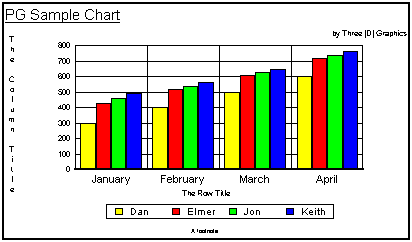
|
|
Notes: |
If you use SetGraphAttr(), you must specify the object ID of a text object to indicate the object to which this attribute is to be applied. See Appendix B for a list of text objects. |
|
Also See: |
A_FONTORIENT |
|
Usage |
ObjectID |
SeriesID |
GroupID |
GraphTypes |
|
Requirements: |
Text |
Optional |
Optional |
All |
| |
|
|
|
|
| |
This attribute sets the background color for text objects. If you use setGraphAttr() to apply this attribute, specify the object ID of a particular text object. |
|
Type: |
typedef struct {
UINT16 red; //0...65535
UINT16 green; //0...65535
UINT16 blue; //0...65535
} RGB16, FAR *RGB16Ptr; |
|
Valid Range: |
See the RGB16 structure in Appendix A. |
|
Default: |
255,255,255 (White) |
|
Example: |
static RGB16 aRGB[8] = {0,0,0}/* BLACK */
SetGraphAttrSI(gpGraph,gpSelItem,
A_FONTBACKCOLOR,&aRGB[1]); |
|
Notes: |
1. |
If you use SetGraphAttr(), you must specify the object ID of a text object to indicate the object to which this attribute is to be applied. See Appendix B for a list of text objects. |
| |
2. |
If you use SetGraphAttr(), you must specify the object ID of a text object to indicate the object to which this attribute is to be applied. See Appendix B for a list of text objects. |
|
Also See: |
A_FONTCOLOR_NONE, A_FONTCOLOR_RGB |
|
Usage |
ObjectID |
SeriesID |
GroupID |
GraphTypes |
|
Requirements: |
Text |
Optional |
Optional |
All |
| |
|
| |
This attribute defines the character set that will be used to draw the specified text object using the font specified by A_FONTNAME. The A_FONTNAME attribute defines a font name, character set, and pitch and family. This attribute can be used to change the character set only. |
|
Type: |
INT16 |
|
Valid Range: |
Use a constant that is defined in your application platform that identifies a font character set (e.g., ANSI_CHARSET). |
|
Default: |
For Windows: ANSI_CHARSET. All others: Zero |
|
Notes: |
1. |
If you use SetGraphAttr(), you must specify the object ID of a text object to indicate the object to which this attribute is to be applied. See Appendix B for a list of text objects. |
| |
2. |
If the selected character set does not exist in your application platform, the system will select a compatible character set that does exit. |
|
Also See: |
A_FONTNAME |
|
Usage |
ObjectID |
SeriesID |
GroupID |
GraphTypes |
|
Requirements: |
Text |
Optional |
Optional |
All |
| |
|
| |
This attribute can be used to make a text object transparent. If the text is transparent, the underlying elements are seen behind the text. |
|
Type: |
BOOLEAN16 |
|
Valid Range: |
TRUE/FALSE |
| |
TRUE= |
This text object has no color; it is transparent. |
| |
FALSE= |
This text object is not transparent; use the normal color settings. |
|
Default: |
FALSE |
|
Notes: |
1. |
If you use SetGraphAttr(), you must specify the object ID of a text object to indicate the object to which this attribute is to be applied. See Appendix B for a list of text objects. |
| |
2. |
This attribute overrides A_FONTCOLOR_RGB when drawing occurs. If A_FONTCOLOR_NONE is TRUE, the font object will remain transparent regardless of A_FONTCOLOR_RGB. |
| |
3. |
Care should be taken in making this attribute available at the user interface level. If a user sets a font to transparent, it will be very difficult to find the font instance again without selecting it since the object is effectively invisible. |
|
Also See: |
A_FONTBACKCOLOR, A_FONTCOLOR_RGB |
|
Usage |
ObjectID |
SeriesID |
GroupID |
GraphTypes |
|
Requirements: |
Text |
Optional |
Optional |
All |
| |
|
|
|
|
| |
This attribute can be used to assign a color to a text object (i.e., labels, titles, etc.). |
|
Type: |
typedef struct {
UINT16 red; //0...65535
UINT16 green; //0...65535
UINT16 blue; //0...65535
} RGB16, FAR *RGB16Ptr; |
|
Valid Range: |
See the RGB16 structure in Appendix A. |
|
Default: |
red = 0, green = 0, blue = 0 (Black) |
|
Example: |
static RGB16 aRGB[4] = {
{ 0, 0, 0},/* BLACK */
{FULL,FULL,FULL}, /* WHITE */
{FULL, 0, 0}, /* RED */
{ 0,FULL, 0}, /* GREEN */
{ 0, 0,FULL}}; /* BLUE */
if (wParam == IDM_TRED)SetGraphAttrSI(gpGraph,gpSelItem,
A_FONTCOLOR_RGB,&aRGB[2]);
if (wParam == IDM_TGREEN)
SetGraphAttrSI(gpGraph,gpSelItem,
A_FONTCOLOR_RGB,&aRGB[3]); |
|
Notes: |
1. |
If you use SetGraphAttr(), you must specify the object ID of a text object to indicate the object to which this attribute is to be applied. See Appendix B for a list of text objects. |
| |
2. |
If an Object ID is not specified or SetGraphAttrSL is used to apply the attribute, the specified color will be applied to all text objects. |
| |
3. |
For more accurate color representations with the ACM_COLOR_MODEL attribute, set this attribute after a DrawTheGraph() or DryRunTheGraph() function. |
|
Also See: |
A_FONTBACKCOLOR, A_FONTCOLOR_NONE |
|
Usage |
ObjectID |
SeriesID |
GroupID |
GraphTypes |
|
Requirements: |
Text |
Optional |
Optional |
All |
| |
|
|
|
|
| |
This attribute can be used to apply a drop shadow to a font object. The drop shadow is drawn with the color specified, offset from the text object by the virtual coordinates specified in nXoff and nYoff. |
|
Type: |
typedef struct {
INT16 nXoff;
INT16 nYoff;
UINT16 nRed;
UINT16 nGreen;
UINT16 nBlue;
} DropShadowInstRec; |
|
Valid Range: |
See the DropShadowInstRec in Appendix A. |
|
Default: |
None |
|
Example: |
DropShadowInstRec Shadow;
Shadow.nXoff = 100;
Shadow.nYoff = 120;
SetGraphAttrSL(gpGraph,gpList,A_FONTDROPSHADOW,&Shadow); |
| |

|
|
Notes: |
1. |
If you use SetGraphAttr(), you must specify the object ID of a text object to indicate the object to which this attribute is to be applied. See Appendix B for a list of text objects. |
| |
2. |
Setting nXoff and nYoff to zero disables any previous drop shadow. Drop shadows are not objects and cannot be selected as a detection node (detnode), they are considered attributes of an object. |
|
Also See: |
A_AREADROPSHADOW |
|
Usage |
ObjectID |
SeriesID |
GroupID |
GraphTypes |
|
Requirements: |
Text |
Optional |
Optional |
All |
| |
|
|
|
|
| |
This attribute defines the font in which a text object will be drawn. |
|
Type: |
typedef struct _FontNameInfo {
char fontName[LF_FACESIZE];
BYTE pitchAndFamily;
BYTE charSet;
INT16 nFlags;
} FontNameInfo, FAR * FontNameInfoPtr; |
|
Valid Range: |
See the FontNameInfo structure in Appendix A. |
|
Default: |
None |
|
Notes: |
1. |
If you use SetGraphAttr(), you must specify the object ID of a text object to indicate the object to which this attribute is to be applied. See Appendix B for a list of text objects. |
| |
2. |
The fontName, pitchAndFamily, and charSet values are application platform specific. They are not defined in the library. If the specified font, pitch and family, and/or character does not exist, the system will select a compatible font that does exist. |
|
Example: |
FontNameInfo HelvFont = {
"Helv",DEFAULT_PITCH,ANSI_CHARSET,0};
FontNameInfo TimesFont = {
"Tms Rmn",DEFAULT_PITCH,ANSI_CHARSET,0};
if (wParam == IDM_HELVETICA)
SetGraphAttrSI(gpGraph,gpSelItem,
A_FONTNAME, &HelvFont);
else if (wParam == IDM_TIMES)
SetGraphAttrSI(gpGraph,gpSelItem,
A_FONTNAME, &TimesFont); |
|
Also See: |
A_FONTCHARSET |
|
Usage |
ObjectID |
SeriesID |
GroupID |
GraphTypes |
|
Requirements: |
Text |
Optional |
Optional |
All |
| |
|
|
|
|
| |
It is now possible to mix single-byte fonts (Romance languages) and multi-byte fonts (Kanji, etc.) in the SAME label. This attribute sets the multi-byte font to use in this scenario. |
|
Type: |
typedef struct _FontNameInfo {
char fontName[LF_FACESIZE];
BYTE pitchAndFamily;
BYTE charSet;
INT16 nFlags;
} FontNameInfo, FAR * FontNameInfoPtr; |
|
Valid Range: |
See the FontNameInfo structure in Appendix A. |
|
Default: |
None |
|
Notes: |
1. |
If you use SetGraphAttr(), you must specify the object ID of a text object to indicate the object to which this attribute is to be applied. See Appendix B for a list of text objects. |
| |
2. |
The fontName, pitchAndFamily, and charSet values are application platform specific. They are not defined in the library. If the specified font, pitch and family, and/or character does not exist, the system will select a compatible font that does exist. |
|
Usage |
ObjectID |
SeriesID |
GroupID |
GraphTypes |
|
Requirements: |
Text |
Optional |
Optional |
All |
| |
|
|
|
|
| |
This attribute can be used to set the orientation of a text object. |
|
Type: |
INT16 |
|
Valid Range: |
0...7 |
| |
#define |
Value |
Description |
| |
FONTORIENT_NORMAL |
0 |
Normal Horizontal Characters |
| |
FONTORIENT_HOTEL |
1 |
Vertical/Hotel Mode Characters |
| |
FONTORIENT_ROTATE_90 |
2 |
Rotate Characters 90 Degrees |
| |
FONTORIENT_ROTATE_180 |
3 |
Rotate Characters 180 Degrees |
| |
FONTORIENT_ROTATE_270 |
4 |
Rotate Characters 270 Degrees |
| |
FONTORIENT_ROTATE_45 |
5 |
Rotate Characters 45 Degrees |
| |
FONTORIENT_ROTATE_315 |
6 |
Rotate Characters 315 Degrees |
| |
FONTORIENT_CUSTOM |
7 |
Use value set by A_FONTORIENTCUSTOM |
|
Default: |
FONTORIENT_NORMAL |
|
Example: |
//Toggle Y1 Text from Normal to Hotel
SetGraphAttr ( gpGraph, GRAPH_LAYER,
O2D_Y1_TITLE,NULL_SERIESID, NULL_GROUPID,
A_FONTORIENT, bIsHotel ); |
| |
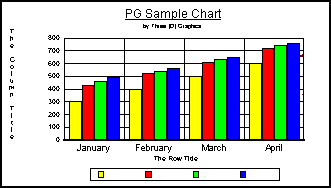
|
|
Notes: |
1. |
If you use SetGraphAttr(), you must specify the object ID of a text object to indicate the object to which this attribute is to be applied. See Appendix B for a list of text objects. |
| |
2. |
This attribute only affects the title objects. It does not affect any other text objects. |
|
Also See: |
A_FONTALIGN, A_FONTORIENTCUSTOM |
|
Usage |
ObjectID |
SeriesID |
GroupID |
GraphTypes |
|
Requirements: |
Text |
Optional |
Optional |
All |
| |
|
|
|
|
| |
This attribute can be used to apply a custom orientation to a Font Object. This attribute is only used if A_FONTORIENT is set to 7 (FONT_ORIENT_CUSTOM). |
|
Type: |
INT16 |
|
Valid Range: |
0..359 |
|
Example: |
int FontOrC = 93;
int FontOr = FONT_ORIENT_CUSTOM
SetGraphAttr ( gpGraph, GRAPH_LAYER,
O2D_Y1_TITLE,NULL_SERIESID, NULL_GROUPID,
A_FONTORIENT, (void FAR *) &FontOr );
SetGraphAttr(gpGraph,GRAPH_LAYER,
O2D_Y1_TITLE, NULL_SERIESID,NULL_GROUPID,
A_FONTOREINTCUSTOM, (void FAR *)&FontOrC); |
|
Default: |
0 |
|
Notes: |
1. |
If you use SetGraphAttr(), you must specify the object ID of a text object to indicate the object to which this attribute is to be applied. See Appendix B for a list of text objects. |
| |
2. |
This attribute only affects the title objects. It does not affect any other text objects. |
|
Also See: |
A_FONTORIENT, A_FONTALIGN |
|
Usage |
ObjectID |
SeriesID |
GroupID |
GraphTypes |
|
Requirements: |
Text |
Optional |
Optional |
All |
| |
|
| |
This attribute selects the pattern of a font. |
|
Type: |
INT16 |
|
Valid Range: |
0...6 |
| |
0 = |
Solid |
| |
1 = |
Horizontal with solid background |
| |
2 = |
Vertical with solid background |
| |
3 = |
Forward diagonal with solid background |
| |
4 = |
Backward diagonal with solid background |
| |
5 = |
Cross with solid background |
| |
6 = |
Diagonal cross with solid background |
|
Default: |
0 (Solid) |
|
Example: |
int FontPat = 2;
SetGraphAttr(gpGraph,GRAPH_LAYER,
O5D_LBLTITLE, NULL_SERIESID,NULL_GROUPID,
A_FONTPATTERN, (void FAR *)&FontPat); |
|
Notes: |
If you use SetGraphAttr(), you must specify the object ID of a text object to indicate the object to which this attribute is to be applied. See Appendix B for a list of text objects. |
|
Also See: |
A_AREAPATTERN, A_LINEPATTERN |
|
Usage |
ObjectID |
SeriesID |
GroupID |
GraphTypes |
|
Requirements: |
Text |
Optional |
Optional |
All |
| |
|
| |
When A_LOCK_FONTSIZE is FALSE, this attribute defines the size of the font that will be used for text object(s) in virtual coordinates. |
|
Type: |
INT16 |
|
Valid Range: |
Any INT16 value. Values in the range 800...2400 are most reasonable. |
|
Default: |
A font instance record is initialized for each of the standard text type objects in a graph (e.g., Title, Subtitle, etc.). The size of the font is different for each text object (e.g., Title = 2360, SubTitle = 1240, etc.). |
|
Notes: |
1. |
If you use SetGraphAttr(), you must specify the object ID of a text object to indicate the object to which this attribute is to be applied. See Appendix B for a list of text objects. |
| |
2. |
If a text object has automatic fitting enabled by one of the auto-fit attributes, this attribute will be ignored. Automatic fitting can be enabled or disabled for the legend text, numeric and ordinal axis labels, and 3D text with A2D_AUTOFIT_ALL, A2D_AUTOFIT_LEGEND, A2D_AUTOFIT_O1/O2, A2D_AUTOFIT_X/Y1/Y2, and A3D_AUTOFIT_TEXT (the Default is automatic fitting enabled). You must specifically disable automatic fitting in order to change the size of these text objects. With automatic fitting disabled, the font size attribute will apply to all labels of the given axis or all legend text objects |
| |
3. |
To convert from point size to virtual coordinates size: |
| |
|
nPtSize=12;
nVCSize=dvScaleHeight(pDE, nPtSize);
setGraphAttrSI(... &nVCSize); |
| |
4. |
If A_LOCK_FONTSIZE is true, use A_FONTSIZE_POINT_100 to change the point size of a text object. |
|
Also See: |
A_FONTSIZE_LIMIT |
|
Usage |
ObjectID |
SeriesID |
GroupID |
GraphTypes |
|
Requirements: |
Text |
Optional |
Optional |
All |
| |
|
|
|
|
| |
This attribute defines the style that will be used for the specified text object. |
|
Type: |
INT16 |
|
Valid Range: |
One of the following: |
| |
#define |
Value |
Description |
| |
FONTSTYLE_BOLD |
1 |
Bold |
| |
FONTSTYLE_ITALIC |
2 |
Italic |
| |
FONTSTYLE_UNDERLINE |
4 |
Underlined |
| |
FONTSTYLE_STRIKEOUT |
8 |
Strike Out |
| |
For example: to display not bold, not italic, with underline use 0x04. to display bold, italic, no underline use 0x03 |
|
Default: |
Zero (normal) |
|
Example: |
static int aFontStyle [4] = {
0, /* NORMAL */
1, /* BOLD */
2, /* ITALICS */
4};/* UNDERLINE */
case IDM_NORMAL:
SetGraphAttrSI(gpGraph,gpSelItem,
A_FONTSTYLE,&aFontStyle [0]);
break;
case IDM_BOLD:
SetGraphAttrSI(gpGraph,gpSelItem,
A_FONTSTYLE, &aFontStyle [1]);
break; |
|
Notes: |
If you use SetGraphAttr(), you must specify the object ID of a text object to indicate the object to which this attribute is to be applied. See Appendix B for a list of text objects. |
|
Also See: |
A_FONTALIGN, A_FONTCHARSET, A_FONTNAME, A_FONTORIENT, A_FONTSIZE_VC |
|
Usage |
ObjectID |
SeriesID |
GroupID |
GraphTypes |
|
Requirements: |
Text |
Optional |
Optional |
All |
| |
The value assigned to this attribute is assigned to the nRed, nGreen, and nBlue members of the glow instance record (GlowInstRec) associated with a given line object. |
|
Type: |
typedef struct {
UINT16 red; //0...65535
UINT16 green; //0...65535
UINT16 blue; //0...65535
} RGB16, FAR *RGB16Ptr; |
|
Valid Range: |
See the RGB16 structure in Appendix A. |
|
Default: |
None |
|
Example: |
glowColor = pVisualize->glowColor;
SetGraphAttrSL( pGraph, pSelList, A_GLOW_COLOR,
&glowColor ); |
| |
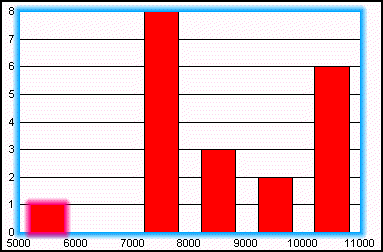
|
|
Also See: |
A_GLOW, A_GLOW_MODE, A_GLOW_THICKNESS
|
|
Usage |
ObjectID |
SeriesID |
GroupID |
GraphTypes |
|
Requirements: |
Any Riser Object |
Optional |
Optional |
All |
| |
|
| |
This attribute is used to change the graph type. nMajorType selects the MAJOR graph type category; nMinorType selects the SUBTYPE for this category. |
|
Type: |
typedef struct{
INT16 nMajorType;
INT16 nMinorType;
} TDG_GraphPresetInfo |
|
Valid Range: |
See the TDG_GraphPresetInfo data structure in Appendix A. |
|
Default: |
nMajorType = 2, nMinorType = 0 |
|
Example: |
void NEAR PASCAL ChangeGraphType (WORD graphID)
{
int iGraph;
TDG_GraphPresetInfo GraphCode;
switch (graphID)
{
case IDM_BAR:
iGraph = 0;
break;
case IDM_CUBE:
iGraph = 1;
break;
case IDM_AREA:
iGraph = 7;
break;
case IDM_SURFACE:
iGraph = 15;
break;
case IDM_PYRAMID:
iGraph = 5;
}
GraphCode.nMajorType = TDG_GRAPH_3D;
GraphCode.nMinorType = iGraph;
SetGraphAttrSL (gpGraph,NULL,
A_GRAPH_PRESET, &GraphCode);
} |
|
Notes: |
Note that some graph type/subtype combinations are perfectly legal but produce a graph type that is not a useable graph in the real world. For example, since the Bar/Line/Area graphs use the same engine code, it is a valid combination to request a Side-by-Side Area chart. However, it is difficult to see what usable information could be derived from such a chart. |
|
Also See: |
A2D_ORIENTATION, A2D_DATAFORMAT, The PGSDK Programmer's Manual for an illustration of each graph type. |
|
Usage |
ObjectID |
SeriesID |
GroupID |
GraphTypes |
|
Requirements: |
No |
No |
No |
All |
| |
This attribute can be used to make a line object transparent. If the line is transparent, the underlying elements will be seen behind it. |
|
Type: |
BOOLEAN16 |
|
Valid Range: |
TRUE/FALSE |
| |
TRUE= |
This line has no color; it is transparent. |
| |
FALSE= |
This line is not transparent; use the normal color settings. |
|
Default: |
FALSE |
|
Example: |
case IDM_SOLID:
{
SetGraphAttrSI(gpGraph,gpSelItem,
A_LINECOLOR_NONE, &bFALSE);
SetGraphAttrSI(gpGraph,gpSelItem,
A_AREACOLOR_NONE,&bFALSE);
SetGraphAttrSI(gpGraph,gpSelItem,
A_AREAPATTERN, &Solid);
SetGraphAttrSI(gpGraph,gpSelItem,
A_AREABACKCOLOR,&aRGB[1]);
} |
|
Notes: |
1. |
If you use SetGraphAttr(), you must specify the object ID of a line object to indicate the object to which this attribute is to be applied. See Appendix B for a list of line objects. |
| |
2. |
This attribute overrides A_LINECOLOR_RGB when drawing occurs. If A_LINECOLOR_NONE is TRUE, the line will remain transparent regardless of the value assigned to A_LINECOLOR_RGB. This attribute must be explicitly set to FALSE in order to see a line's color. |
| |
3. |
Great care should be taken in making this attribute available at the user interface level. If a line is made transparent, it is effectively invisible and would be almost impossible to select. |
| |
4. |
Lines are the borders that are drawn around areas. For example, bar risers, borders, and the chart frame are line objects. Lines can also be drawn by themselves, for example, the feelers on a pie chart |
|
Also See: |
A_LINECOLOR_RGB |
|
Usage |
ObjectID |
SeriesID |
GroupID |
GraphTypes |
|
Requirements: |
Line |
Optional |
Optional |
All |
| |
|
|
|
|
| |
This attribute sets the color value of a line in Red/Green/Blue increments. |
|
Type: |
typedef struct {
UINT16 red; //0...65535
UINT16 green; //0...65535
UINT16 blue; //0...65535
} RGB16, FAR *RGB16Ptr; |
|
Valid Range: |
See the RGB16 structure in Appendix A. |
|
Default: |
red = 0, green = 0, blue = 0 (Black) |
|
Example: |
static RGB16 aRGB[2]= {
{ 0, 0, 0}, /* BLACK */
{FULL,FULL,FULL}}; /* WHITE */
SetGraphAttrSL(gpGraph,gpList,A_LINECOLOR_RGB,&aRGB[i]); |
|
Notes: |
1. |
If you use SetGraphAttr(), you must specify the object ID of a line object to indicate the object to which this attribute is to be applied. See Appendix B for a list of line objects. If an Object ID is not specified or SetGraphAttrSL is used to apply the attribute, the specified color will be applied to all line objects. |
| |
2. |
For API usage via Set/GetGraphAttr(), a copy of the structure RGB16 should be used (e.g., RGB16 myRGBstruct;). |
| |
3. |
The library does not modify the system color palette. If your application requires colors in addition to those in the system palette, your application must create and realize a logical palette into the system palette. |
| |
4. |
Lines are the borders drawn around areas, for example, bar risers or the chart frame. Lines can also be drawn by themselves, for example, the feelers on a pie chart. |
| |
5. |
For more accurate color representations with the ACM_COLOR_MODEL attribute, set this attribute after a DrawTheGraph() or DryRunTheGraph() function. |
|
Also See: |
A_LINECOLOR_NONE |
|
Usage |
ObjectID |
SeriesID |
GroupID |
GraphTypes |
|
Requirements: |
Line |
Optional |
Optional |
All |
| |
|
|
|
|
| |
This attribute is used to specify the style of a line object. |
|
Type: |
INT16 |
|
Valid Range: |
0...15 |
| |
Value |
Line Pattern Type |
Description |
| |
0 = |
Solid |

|
| |
1 = |
Dash |

|
| |
2 = |
Dot |

|
| |
3 = |
Dot and Dash |

|
| |
4 = |
Dash and two Dots |

|
| |
5 = |
Medium Dash |

|
| |
6 = |
Short Dash |

|
| |
7= |
Longest Dash |

|
| |
8= |
Long Dot |

|
| |
9= |
Dot Dot Dot |

|
| |
10= |
Dash Dash Dot |

|
| |
11= |
Dash Dash Dot, Dot |

|
| |
12= |
Long Dash Dot |

|
| |
13= |
Long Dash Dot Dot |

|
| |
14= |
Long Dash Dash Dot |

|
| |
15= |
Long Dash Dash Dot Dot |

|
|
Default: |
0 (Solid) |
|
Example: |
static INT16 pat[5] = {1, 2, 3, 4, 5};
SetGraphAttrSI (gpGraph,gpSelItem,
A_LINEPATTERN, &pat[1]); |
|
Notes: |
1. |
If you use SetGraphAttr(), you must specify the object ID of a line object to indicate the object to which this attribute is to be applied. See Appendix B for a list of line objects. If an Object ID is not specified or SetGraphAttrSL is used to apply the attribute, the specified pattern will be applied to all line objects. |
| |
2. |
Lines are the borders drawn around areas, for example, bar risers or the chart frame. Lines can also be drawn by themselves, for example, the feelers on a pie chart. |
|
Also See: |
A_LINESFX, A_LINEWIDTH |
|
Usage |
ObjectID |
SeriesID |
GroupID |
GraphTypes |
|
Requirements: |
Line |
Optional |
Optional |
All |
| |
|
|
|
|
| |
When A_LOCK_FONTSIZE is FALSE, this attribute defines the width of a line object. |
|
Type: |
INT16 |
|
Valid Range: |
Any positive INT16 value identifying the width of the line in virtual units. A value of 50...100 is roughly equivalent to one pixel. |
|
Default: |
1 |
|
Example: |
int nSeriesID = 2;
int LineWidth = 50;
SetGraphAttr(gpGraph,GRAPH_LAYER,
O2D_MOVAVGLINE, nSeriesID,
NULL_GROUPID, A_LINEWIDTH,(void FAR *)&LineWidth); |
|
Notes: |
1. |
If you use SetGraphAttr(), you must specify the object ID of a line object to indicate the object to which this attribute is to be applied. See Appendix B for a list of line objects. If an Object ID is not specified or SetGraphAttrSL is used to apply the attribute, the specified width will be applied to all line objects. |
| |
2. |
To create a line that is three pixels wide: |
| |
|
nPixelWidth=3;
nvWidth = dvScleHeight(pDE, nPixelWidth);
setGraphAttr(... &nvWidth); |
| |
3. |
If A_LOCK_FONTSIZE is true, use A_LINEWIDTH_POINT_100 to change the width of a line object. |
|
Also See: |
A_LINEPATTERN, A_LINESFX |
|
Usage |
ObjectID |
SeriesID |
GroupID |
GraphTypes |
|
Requirements: |
Line |
Optional |
Optional |
All |
| |
|
| |
This attribute defines the location and size of the bounding box of the footnote object (O5D_LBLFOOTNOTE). The location and size of the bounding box are specified in virtual coordinates. |
|
Type: |
typedef struct
{
INT16 xULC, yULC;
INT16 xLRC, yLRC;
} BoxInstRec, FAR *BoxInstPtr; |
|
Valid Range: |
See the BoxInstRec structure in Appendix A. |
| |
xLRC, yLRC: INT16 value in the range +/- 16383 identifying the lower right corner location in virtual coordinates (e.g., 16383, -16383 = lower-right most corner of window, 0,0 = center of window) |
|
Default: |
xULC = VirtualXMIN (-16383) + 1000, |
| |
yULC = VirtualYMIN (-16383) + 150 |
| |
xLRC = VirtualXMAX (16383) - 100 |
| |
yLRC = VirtualYMIN (16383) + 50 |
|
Example: |
aRect = r2;
// Convert to Virtual Coordinates
dvRect(gpDrawEnv, &aRect);
if (gpSelItem->nObjectID == O5D_LBLFOOTNOTE)
SetGraphAttrSI(gpGraph, gpSelItem,
A_LOCATE_FOOTNOTE, &aRect); |
|
Also See: |
A_SHOW_FOOTNOTE |
|
Usage |
ObjectID |
SeriesID |
GroupID |
GraphTypes |
|
Requirements: |
No |
No |
No |
All |
| |
|
| |
This attribute defines the location to draw the chart frame within the drawing area. The chart is drawn within the frame defined by A_LOCATE_FRAME. The location is defined in virtual coordinates. The background of the chart occupies the entire area defined by the virtual coordinates |
| |
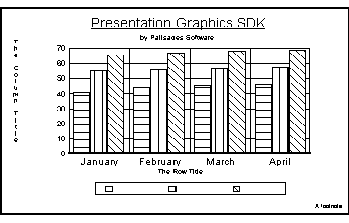
|
|
Type: |
typedef struct {
INT16 xULC,yULC;
INT16 xLRC,yLRC;
} BoxInstRec, FAR *BoxInstPtr; |
|
Valid Range: |
See the BoxInstRec structure in Appendix A. |
|
Default: |
xULC = -10537, yULC = 10425, xLRC = 12640, yLRC = -6629 |
|
Notes: |
1. |
Do NOT put the Upper Left Corner below or to the right of the Lower Right Corner in an effort to mirror the chart. If you want the chart to be upside down, or mirrored, draw to a memory DC and manipulate the bitmap. |
| |
2. |
The values of the coordinates cannot exceed the limits of the virtual coordinate rectangle defined by VirtualXMIN, VirtualXMAX, VirtualYMIN, and VirtualYMAX. |
|
Usage |
ObjectID |
SeriesID |
GroupID |
GraphTypes |
|
Requirements: |
No |
No |
No |
All |
| |
|
|
|
|
| |
This attribute defines the position and size of the bounding box of the subtitle object (O5D_LBLSUBTITLE). The location and size of the bounding box are specified in virtual coordinates. |
|
Type: |
typedef struct {
INT16 xULC, yULC;
INT16 xLRC, yLRC;
} BoxInstRec, FAR *BoxInstPtr; |
|
Valid Range: |
See the BoxInstRec structure in Appendix A. |
|
Default: |
xULC = VirtualXMIN (-16383) + 1000 |
| |
yULC = yLRC of Title object (O5D_LBLTITLE) |
| |
xLRC = VirtualXMAX (16383) - 1000 |
| |
yLRC = yULC of Title object (O5D_LBLTITLE) - 200 |
|
Example: |
aRect = r2;
// Convert to Virtual Coordinates
dvRect(gpDrawEnv, &aRect);
if (gpSelItem->nObjectID == O5D_LBLSUBTITLE)
SetGraphAttrSI(gpGraph, gpSelItem,
A_LOCATE_SUBTITLE, &aRect); |
|
Also See: |
A_SHOW_SUBTITLE |
|
Usage |
ObjectID |
SeriesID |
GroupID |
GraphTypes |
|
Requirements: |
No |
No |
No |
All |
| |
|
| |
This attribute defines the position and side of the bounding box of the title object (O5D_LBLTITLE). The position and size of the bounding box are specified in virtual coordinates. |
|
Type: |
typedef struct {
INT16 xULC, yULC;
INT16 xLRC, yLRC;
} BoxInstRec, FAR *BoxInstPtr; |
|
Valid Range: |
See the BoxInstRec structure in Appendix A. |
|
Default: |
xULC = VirtualXMIN (-16383) + 20 |
| |
yULC = VirtualYMAX - 20 |
| |
xLRC = VirtualXMAX (16383) - 20 |
| |
yLRC = VirtualYMAX - 450 |
|
Example: |
aRect = r2;
// Convert to Virtual Coordinates
dvRect(gpDrawEnv, &aRect);
if (gpSelItem->nObjectID == O5D_LBLTITLE)
SetGraphAttrSI(gpGraph, gpSelItem,
A_LOCATE_TITLE, &aRect); |
|
Also See: |
A_SHOW_TITLE |
|
Usage |
ObjectID |
SeriesID |
GroupID |
GraphTypes |
|
Requirements: |
No |
No |
No |
All |
| |
|
